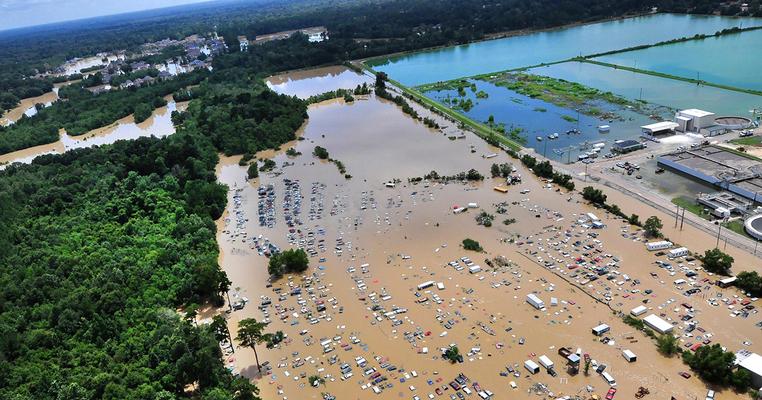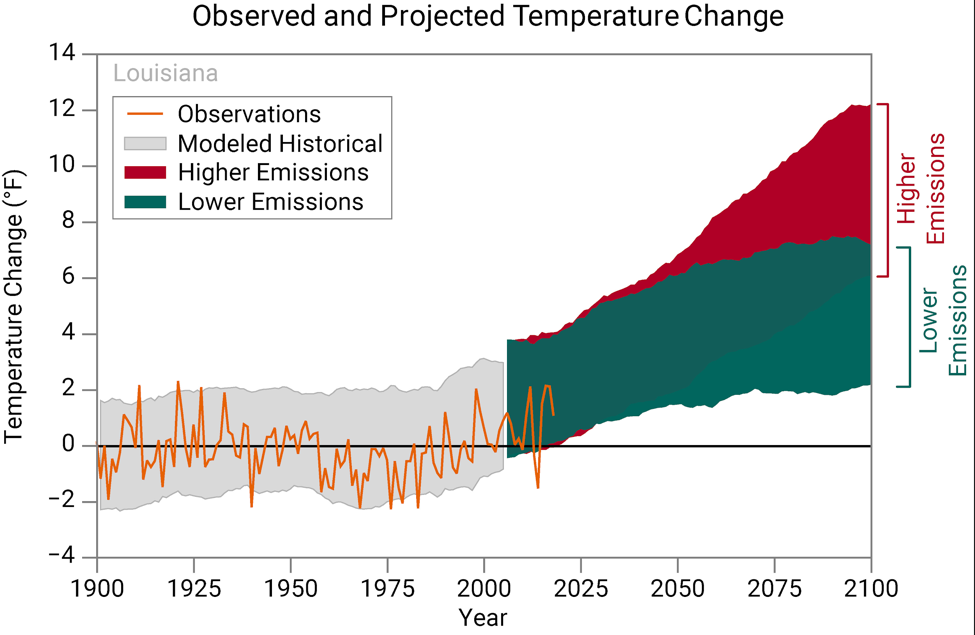
WE®: How the Climate Crisis is Affecting Louisiana

It’s hard not to fall in love with Louisiana.
The boot-shaped state sits above the Gulf of Mexico, between Texas and Arkansas, and is home to world-famous Cajun and Creole cuisine, Mardi Gras, and one of best live music scenes anywhere. And who could forget the beignets? No one, that’s who.
But for Louisianans, the climate crisis is already an everyday reality, especially when it comes to hurricanes, flooding, and sea-level rise. (That's why we'll be next door in Texas in April to train grassroots activists to #LeadOnClimate in their communities. Apply to join us today.) Read on to learn more about how climate change is already impacting the Bayou State.
Heat
Here’s the climate reality: Over the twentieth century, Louisiana, an already hot and humid state, saw relatively little additional warming. But without climate action, the state could experience unprecedented heat by the end of this century.
In a high-emissions scenario, Louisiana could see average temperatures rise more than 10 degrees Fahrenheit by 2100 (compared to 1901-1960 average). That’s a dramatic change – but it doesn’t take 10 degrees before temperature changes significantly impact our lives. Even just a few degrees can take a toll on humans and the systems we depend on.

According to data from Climate Central, Louisiana had about 35 dangerously hot days per year as of 2015. But by 2050, the Bayou State “is projected to average nearly 115 danger days a year.” This is one of the largest projected increases in the nation.
Extreme heat like this can be very dangerous for the human body, overwhelming our ability to maintain a healthy, stable internal temperature. One of the best mechanisms we have to keep cool is our ability to sweat. But if it’s both very hot and very humid (as it often is in Louisiana), sweat isn’t able to evaporate from our skin, preventing our ability to cool down. Extremely hot days like these are especially dangerous for children, the elderly, and those who work outside.
As of 2015, more than 160,000 people in Louisiana were already vulnerable to extreme heat. So while the already very hot state has not yet experienced consistently higher-than-average temperatures like many other states around the country, it’s only a matter of time before that warming arrives and climate change-driven extreme heat dramatically impacts the lives of Louisianans.
>> Related: Climate Change and Health: Heat Waves <<
Hurricanes
Here’s the climate reality: Louisiana is frequently battered by tropical storms and hurricanes. As oceans warm, these storms are expected to become more and more intense.

In August 2005, Hurricane Katrina made landfall and absolutely devastated Florida and Louisiana, especially the city of New Orleans. The damage was catastrophic: nearly 1,200 Louisianans died, 80 percent of the city was under water, and damages totaled more than $100 billion. Today, the Category 3 hurricane is considered one of the worst natural disasters in US history.
While it’s hard to say how much of Hurricane Katrina’s enormous power was connected to our changing climate (it’s difficult to link any one specific weather event entirely to climate change), we do know that, in general, warmer temperatures tend to mean more-powerful hurricanes. That’s because climate change doesn’t just mean changing temperatures on land — our oceans are getting warmer, too. And like fuel for an engine, warmer sea water helps drive stronger and stronger hurricanes.
As famed climate scientist Dr. Michael Mann explained in an interview with Climate Reality, “For a long time, we’ve understood, based on pretty simple physics, that as you warm the ocean’s surface, you’re going to get more intense hurricanes. Whether you get more hurricanes or fewer hurricanes, the strongest storms will tend to become stronger.”
Between 2005 and 2019, Louisiana was hit by at least nine hurricanes (and many more tropical storms), including 2017’s Hurricane Harvey. While none have been as devastating as Katrina, these storms significantly impacted the lives and livelihoods of Louisianans, especially low-income communities. A 2005 article from ABC News made the reality stark: “In New Orleans, a third of the residents live below the poverty line. The very poorest live on the lowest land, south of Lake Pontchartrain, where the floodwater is now up to their rooftops.”
This is the reality for all natural disasters: They tend to hit the most vulnerable among us the worst. As noted by the Brookings Institute, “Low-income and minority communities are more vulnerable to the risks of natural disasters, and they also struggle most to recover.” Brookings goes on to explain why:
1. Lower-income Americans are more likely to live in neighborhoods or buildings more susceptible to storm impacts.
2. Poorer families are less insulated against the economic shocks that often accompany the physical ones.
3. More-affluent people can more easily relocate to safer areas.
Flooding and Sea-Level Rise
Here’s the climate reality: Louisiana is the most flood-prone state in the union. As our climate changes, floods in the state are expected to become more frequent and intense.
Certainly the hurricanes that make landfall in Louisiana cause severe flooding, but the state experiences “all three types of flooding — coastal (surge and tidal), fluvial (riverine), and pluvial (intense rain causing surface flooding).”
Why? For one, at its lowest elevation, the Bayou State is already a full eight feet below sea level. For another, higher temperatures are related to more frequent flooding, more intense flooding, and sea level rise. Simply put, the climate crisis intensifies our water cycle — meaning a warmer world is often a wetter world.
The report “Louisiana’s Strategic Adaptations for Future Environment (LA SAFE)” summarizes the many interconnected, flood-related risks that the state faces as a result of climate change:
“With climate change, sea levels are expected to rise in the Gulf of Mexico and waterways in coastal Louisiana. Recently, storms that have affected the region have also increased in frequency and intensity. Relative sea level rise, which is rising waters combined with subsidence, poses a double threat to coastal Louisiana. Increasing water levels bring higher high tides, and subsidence results in sinking land. This accelerated risk means that flooding will reach higher levels of elevation at a faster rate.”
This is already affecting people today. Louisianans who live in low-lying, disaster-prone areas are moving to higher ground (if they are able). As a result, these communities, which already tend to be poorer than others, see an increase in poverty rates.
>>Related: The Climate Crisis and Flooding: What You Need to Know <<
The good news? In 2019, Louisiana released the LA SAFE plan, which charts a path forward to help residents adapt to the reality of an already climate-changed state. The report puts it starkly: "Louisiana is in the midst of an existential crisis. Its response to this crisis can either lead to a prosperous renaissance or to a continued and sustained cycle of disaster and recovery."
But adaptation is not enough. It’s up to all of us to solve climate change, not just to adapt to the worst effects of this crisis. That’s why we’ve trained thousands of Climate Reality Leaders across the world to inspire action and advocate for solutions in their communities.
Do you want to be part of the movement to solve the climate crisis? Join us for our next Climate Reality Leadership Corps training and leave with the knowledge and tools to shape public opinion, inspire action in your community, and lead the global fight for solutions.
As one Climate Reality Leader said, “This training provides the groundwork for sharing the facts and educating others about the climate crisis in a respectable, fun, digestible, and educational way… It leaves you with a sense of hope.”
We’ll be in cities across the US in 2020. Learn more about becoming a Climate Reality Leader and apply today!

